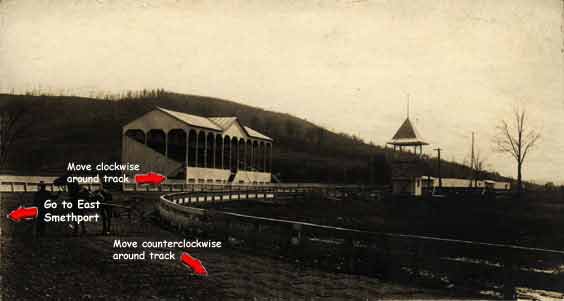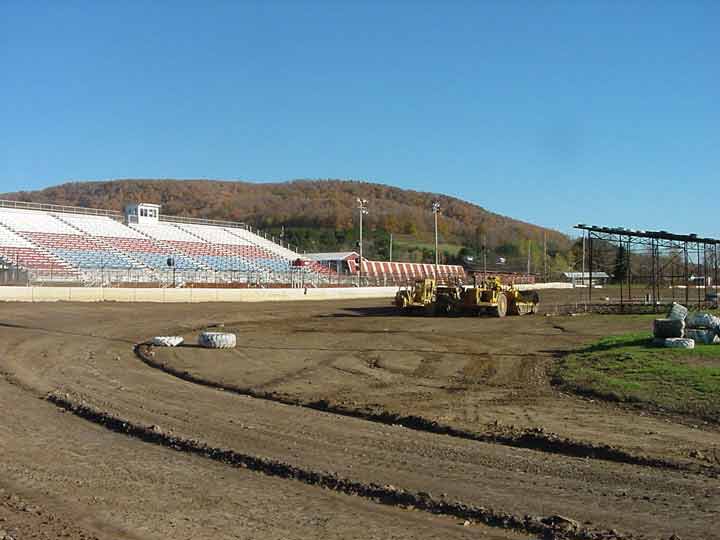1905 McKean County Fairgrounds

photo credit: John G. Coleman Collection

photo credit: John G. Coleman Collection
In 1905, farmers were making plans to drive their cattle to the McKean County Fair in Smethport because it was one of the biggest events in the area. Nowadays, the cows are not herded to the fair but it is still one of the biggest events in the county. The McKean County Fair Association can trace its roots back to a new racetrack and buildings first used on Oct. 3-6, 1905. According to the McKean County Miner of April 6, 1905 "enterprising citizens" had wanted "for some time" a race track and fair buildings near Smethport. The track to draw horses and trainers into the area for business and the buildings to attract farmers to display their produce and animals at a fair.
It was pointed out that Smethport was ideally located for a fairgrounds in the center of the county, and that the railroad system coming together at Smethport made it possible for residents throughout the county to travel to the fair in the morning, spend a few hours, then return home in the evening. Although most residents from the area equate the month of August with the event, in its early days, the fair was always held after Labor Day in September. The date was later changed to August due to the unpredictable weather in September. School children in the area were often dismissed from classes to allow them the time to attend the event.
Stock was sold, first in the amount of $1,500, and later, in June, $5,400
with the facility an "assured fact." With Robert W. Hilton of Smethport
promoting the project and a Mr. Dawson, a track-builder from Wellsville,
N.Y., supervising the construction, the track and fairgrounds were built
on the Hilton and Nourse farms in East Smethport, were just completed by
the beginning of October 1905, in time for the first fair. The first officers
for the county fair association were R.W. Hilton, president; C.D. Comes,
vice president; F.D. Gallup, secretary; B.F. Garlick, assistant secretary;
James A. McKean, treasurer; and F.L. Sherburne, supervisor. The first directors
were Hilton, Comes, Gallup, McKean, and Sherburne.

The first fairgrounds consisted of four main facilities: a grandstand, a combination bandstand/judges' stand, stables, and ball grounds. The grandstand, seating 1,000 people, was built near the track's first turn and was constructed so that spectators could see the whole race as well as the finish without rising from their seats. Although the first county fair was supposed to begin on Tuesday, Oct. 3, rain delayed the official opening until Wednesday, Grange Day. By horse race time, an important part of the first fair, 2,500 people were on the grounds, riding the two Ferris wheels and the merry-go-round, and participating in the 40 attractions on the midway or Pike. Ten automobiles drove on the grounds, carrying the fair directors, speakers and prominent citizens. Exhibits seen included produce and farm animals and machinery, as well as goods from local stores such as Redfields's Hardware.
Helping Hilton, who did much to promote the fair, was James Connelly, leather products manufacturer of Ludlow, and John C. Looker, a Bradford oil producer. The men donated both money and business skills to the association and proposed the change of ownership from stockholders to the county -a move made in 1936 that prevented the possible loss of the grounds after the fairs close in 1942. Other early leaders in the fair's growth were George Simpson of Bradford, county Democratic chairman; Russell Lindsley, publisher of the McKean County Democrat; and Henry J. Rice and Bernard T. Garlick, fair secretaries at different times.
In 1910 the fair was well established. An airplane flight was introduced that year. The fair of 1913 also saw an "aeroplane," whose pilot thought the track wide enough to allow take-off: it crashed after 50 feet of flight, destroying the craft. The same year, the fair, never a financial success, was threatened with public sale due to out-standing bills. O.J. Hamlin, a Smethport banker, intervened, however, guaranteeing its indebtedness for the year as well as $700 for the next five years.
It was reported that an accident marred the festivities of the 1914 fair - a priest from Smethport drove his automobile through an open gate onto the race track during a race; a horse ran into the car, causing injury to the driver, priest and horse. A "better babies" contest highlighted the 1915 event, a competition in which babies were sought who were "100 percent" in the eyes of the judges. Four were selected winners and a drawing decided the victor.
A state quarantine for infantile paralysis caused the fair of 1916 to be canceled. It resumed in 1917 with state funds to pay the premiums, thanks to an act of the Pennsylvania Legislature passed that year. Bradfordian Harri Emery gave daily plane rides to fairgoers in the 1920 fair, which also featured nighttime carnivals.
The year 1925 was the first time the fair was lit with electricity, a luxury which had come to Smethport only that year. New grandstands were also constructed and the fair events were broadcast over the radio for the first time, with a Buffalo, N.Y., radio studio providing the play-by-play. This was also the year in which the fair association purchased the fairground land from O.D. Nourse. In 1926, Connelly and Looker contributed large amounts of money to boost the fair's building program. The first two horse barns were also constructed that year. A Mardi gras was featured during the 1931 fair, with fair goers arriving in costume and prizes given for outstanding dress.
Transfer of the ownership of fair land to the county came in 1936, with the county allowing the association to use the land ever since. A crowd of 15,000 people during the first day of the 1938 fair broke the institution's attendance one-day record. As the county residents changed more from agriculture to industry, the fair adjusted by providing more night time entertainment for residents working during the day. Parades featured fire departments and bands, and with brightly lighted midways, gradually replaced afternoon horse races as the main attractions.
Along with World War II came a tightening of time and resources and the county fair was not held in 1942 or for some years to come. The fairgrounds sat unused for about a dozen years when Russell J. Weston, who has become president of the fair association in 1953, began a drive, along with others, to revive the fair.
The grounds and buildings had fallen into disuse by this time. Many
volunteers, individuals and organizations, gave time and effort to renovate
the fairgrounds, including the fire departments and county granges - the
president remembers particularly working on the barn roof at that time.
The grandstand was rebuilt, the race track cleared and barns and other
buildings repaired, and the fair opened on Labor Day, 1954, with record-breaking
crowds making the fair bigger than ever. After that, for all years to come,
newer attractions, rides, and singers were added to the fair's events and
we now have our current McKean County Fair.
Text credit: Roger Newton
(Era Staff Writer)

photo credit: Bridgett Sircy 2001